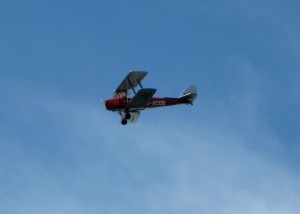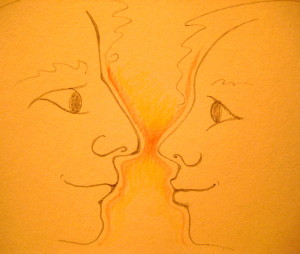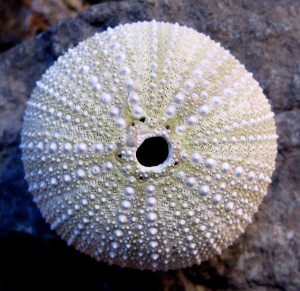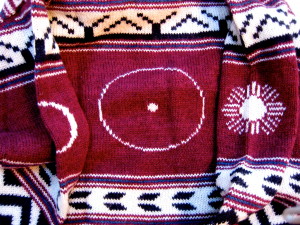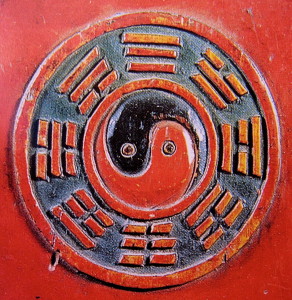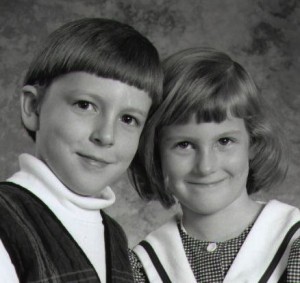In a dream, Jan and I are parked in our little black car in a vast Stop & Shop supermarket parking lot. We’re just sitting, quietly and calmly, Jan in the driver’s seat, I next to her in the passenger seat. A pick-up truck pulls in tightly to my side. A man opens his door, which smacks into our door. I’m not particularly fazed and turn to Jan and say: “See, that’s how we get those marks on the car when we’re parked.”
The man, who didn’t skip a beat after hitting into the door, walked away obliviously—we simply didn’t exist for him. He took no responsibility whatsoever for having left a scratch on our little car. However, after I made that comment to Jan, he turned and got back into his truck and pulled out, cutting his wheels too much and causing his car to catch part of our bumper and actually begin to drag us along. Eventually, it unhinged, but just as before he acted completely oblivious; not that he was refusing to take responsibility, but even more profoundly, he simply didn’t care even to waste the energy on us to defend himself—we simply didn’t exist.
I had this dream the night it was exposed that Pachamama had used Tweetie Bird to bring down Anthony Weiner, just another of her recent targets: high-powered men who abuse their power. This dream dramatizes the utter blindness, narcissism, and outright disregard by masculine energy when it dominates the personality. What this means inwardly for such a domineering individual is the total negation of the feminine energy within the self.
The feminine energy within all selves, male and female, is the energy that opens, receives, holds, joins, and nurtures life, bringing us into a deep experience of interconnectedness and oneness of all things. Feminine energy, when polarized and dominant, can bring forth death and destruction to clear the way for new life. We find ourselves in such a time now. Pachamama has gained the ascendancy after centuries of polarized abuse by dominant masculine power. Pachamama is on the warpath, and we are all feeling the impact of her path of destruction, as she prepares the planet for new life.
My dream dramatizes the abuse of masculine power that has led to Pachamama’s targeted rebalancing efforts. In the dream, the existence of Jan and I, our car, and damage to our car are not only dismissed; there is no evidence of any feminine energy present in this man to value or care about us. In the case of the driver of the truck, his dominant masculine energy is in the service of his narcissistic self: oblivious, unfeeling, and completely dismissive of the world around him. Whose needs within the self are being served by this tyrannical, self-serving despot who is blind to the needs or even existence of others? I propose that the culprit is a very primitive ego state, in control behind the scenes of what appears to be an adult.
There is a stage in the ontological development of the psychological self that Freud termed primary narcissism. Margaret Mahler called this same stage symbiosis to highlight the oneness of the unit of parent and child. Esther Harding coined the term autos to define this stage. I will use Ester Harding’s term autos to capture the ego state that all of these pioneers in psychology were talking about when reflecting upon the experience of the human being in earliest infancy.
In infancy, it is normal and appropriate to be completely absorbed within the narcissistic shell of the self. At this age there is no differentiation of self and other. Self is everything. At this stage of near utter helplessness the world must revolve around the needs of the infant—even read those needs without them being expressed—for that infant to survive and thrive. To the infant, the parent’s needs for sleep, rejuvenation and recreation don’t matter—they simply don’t exist. Plain and simple, the world is all about ME, as it should be, AT THAT AGE.
As development progresses beyond infancy, consciousness gradually awakens to a world of others, separate beings with their own needs. Growing up becomes a progressive paring down—or suppression of the world view and the power of the early stage of primary narcissism, with its primitive ego state of autos—in the service of becoming an autonomous independent person, capable of caring for self and becoming a contributing member of an interdependent community.
The charming baby of infancy, once cooed over, becomes the big baby of adulthood if it fails to acquiesce to more socialized and autonomous ego states. In truth, the autos of yesteryear remains an enduring ego state in all adults. All must struggle with the desire to return to the safety and security of being totally taken care of, loved, provided all that she/he needs or wants; the expectation of needs being met simply because they are so important.
This autos ego state may have been thrown out of the Garden too soon, never allowed to fully experience safety and love, or it may have been neglected and abused, or it may simply continue its longing to return to that paradisal state of oneness—without any effort. Nonetheless, as we emerge from early childhood our autos is forced into the background as we must navigate and adapt to the complexities and expectations of a world that demands that we too give.
When the autos remains dominant we find the child who demands all the focus and all the toys. In the autos state we want what we want when we want it. The autos has no energy to think about you. In truth, as with the truck driver in my dream—you simply don’t exist. And if you do exist your value lies only in your ability to serve the elemental needs of comfort, security, and pleasure. If an adult is covertly possessed by the autos ego state, beware its Trojan horse—often called seduction. The true motive may be to draw you in, ultimately to serve its own needs of comfort, security, and pleasure.
Anthony Weiner, in my judgment, is just the latest example of a man covertly controlled by his autos, emboldened and empowered by the dominant control of masculine energy. Sending an anatomical picture over the Internet and having tantalizing on-line dialogue is still, ultimately, an absorption in self-pleasuring. All interaction and stimulation takes place in the imagination, within the self. “Sexual contact” at this level is masturbatory—an offshoot of narcissism and self-pleasuring—it’s safe, you’re in total control. BUT, there is no real relationship, real connection, with a real person. This type of contact, actually, suspends real-ity. Real contact with a real woman or other person requires opening up to the feminine energy within the self, in all sexes. Only through that feminine energy can true merging and contact be made to unite with another.
Furthermore, even if Anthony Weiner made real contact with a woman he’d met on the Internet he is not a real person at that meeting. He is a fragmented being who has left his husband self at home. The bottom line: real relationship is simply too much work for the adult possessed by their autos.
Women are not exempt from the dominance of male energy within the self acting in the service of the autos either. Women must examine their own modus operandi in choosing partners. If, secretly, the autos’s need for safety and security, completely provided by another, is in control of the personality, then that woman’s masculine energy may act decisively on the autos’s behalf, choosing a dominant narcissistic partner who demands a caretaker/lover that the woman might overtly protest, but covertly covet, feeling secure in being taken care of.
At the other extreme, the autos may enlist the dominant masculine energy to choose a passive partner to covertly be assured of getting what she wants, though she might overtly protest that partner’s lack of drive, imagination, or initiative.
All must assume responsibility now for scrutinizing the interplay between masculine and feminine energies within the self. We are on the precipice of a major shift away from a free ride for dominant masculine energy control. All are charged to act in concert with Pachamama toward a new balance. But behind this balance of energetic forces lies the autos self, which must be reckoned with and put to bed. Pachamama has little nurturance or patience for the autos ruling an adult. In fact, as is abundantly evident, it arouses her destructive fury.
Time to get out of the nest and take responsibility, as an adult self, for the greater interconnected needs and survival of all.
Chuck
P.S.: I had completed this blog the other night and read it to Jan. Though it felt complete, I sensed there was something more to be said. I woke last night thinking of the blog and then had this dream:
Jan and I are in a rural setting. An old bridge had been repaired. It’s not a bridge of much consequence, but it’s the only bridge to get to the road that leads to more significant bridges.
I am driving over the bridge a little too fast. It’s only a narrow two-lane bridge. Suddenly, an oncoming car swerves directly at us with what appears to be an inevitable head-on collision as there is no place for me to go. At the last second the other car swerves back into its lane and we both stop.
I rush over to the driver, an Asian woman, who has already gotten out of her car and is busily typing on her laptop. I am now the observer, as she and a man take off their clothes. She mounts him and they begin to have intercourse. Suddenly, another woman, an older woman, appears who watches them intensely, first with an expression of shock, then anger, then jealousy, and finally deep wrenching sadness. As the Asian woman orgasms the older woman holds her, desperately trying to share some aspect of her experience.
This dream dramatically stops me and insists that I include one more point in my blog. The older woman in this dream embodies the impact of her controlling dominant masculine energy upon her own fulfillment. The experience of orgasm is a door to the deep feminine energy of Kundalini, an energetic rapture of ecstatic proportion. Letting go to such an engulfment can be fraught with fear for anyone, whether alone in a masturbatory experience of self-union or with a partner.
A woman might call upon her masculine energy to shut down her deep feminine energy under the terror of loss of self and dissolution—just as a man might limit his sexual experience to images of woman or objectified, depersonalized interactions with an actual woman—similarly protecting herself from the terror of loss of self in engulfment or failure in actual relational experience. In this case, the dominance of the autos ego state is protection at a very primary level. It is likely that the psyche, in this case, is housing a tremendum of unrecapitulated trauma that the autos, in its striving for safety, directs its masculine energy to cut off and protect itself from, resulting in loss of the feminine.
The challenge for both sexes is to release the stranglehold of control that dominant masculine energy can have on the need for deep union within the self, with a partner, and with the greater world. However, we must look beyond the dominance of masculine energy and address who is really in control and why.
